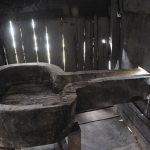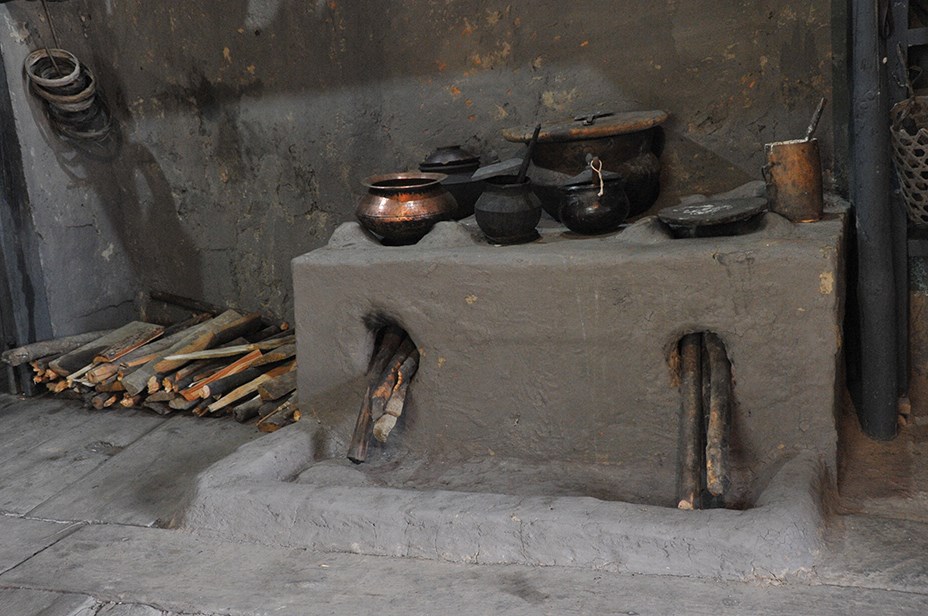The manor house of Nyangmey village in Tsento, Paro, belonged to Nyangmey Chukmo, the aristocrat of the village. Now called Nyangmey Village Museum, the three-storey mediaeval house preserves the last vestiges of Bhutan’s past that is fast disappearing.
First built by Tshongpon Gonpo for his root lama, Kathog Rigzin Chenpo, before the 17th century, the house of Nyangmey Chukmo has survived – almost unscathed – the onslaught of modernisation, thanks to Tshongpon Gonpo’s unbroken line of descendants.
One approaches the museum through a canopy of fruit trees surrounding the mud rampart built around the house. When the trees are laden with fruits, a visitor can pick apples, peaches, walnuts, or grapes. And as one enters through the huge rampart door, the dark, mud-rammed house stands tall, still proud despite the all too clear ravages of time written all over her.

Lying scattered within the rampart, unused and decaying, are ploughs and yokes, cauldrons, and woks. The ground floor, which served as the cattle shed, is heavy with the smell of old manure turning into humus. The dark, claustrophobic space is complete with feeding troughs and tether pegs.
The first floor houses the family granary and the guest chamber. Nyangmey Chukmo or Rich Lady of Nyangmey was known to have owned a huge landed estate and commanded a considerable number of serfs. Nyangmey Chukmo was one of the seven aristocratic families in Paro. The Chukmo family held considerable influence in Paro by virtue of its wealth and religious descent.

A rickety, wooden stair leads one to the top floor which houses the kitchen, shrine room, living room, bedrooms, and storeroom. The sooty kitchen is a mosaic of peculiar things from the mediaeval Bhutan. On the mud oven sits earthen and brass pots of varying sizes. On the nearby racks sit wine containers, a leather oil container, baskets, and a brass lamp. None of these is used today. Although it has not been used for a long time now, the kitchen still smells of ‘home’ associated with traditional farm houses.
A small room adjoining the spacious shrine room, just big enough for one person to sleep, was the bedroom of Je Sherub Gyaltshen, the 25th Je Khenpo (chief abbot) of Bhutan. Je Sherub Gyaltshen (r. 1836-1839) hailed from the house of Nyangmey Chukmo and enjoyed spending quiet nights in his little bedroom from where the sacred Taktshang can be seen like a little beacon. He often sat up in his bed, slid open the window, and meditated with the faraway Taktshang Monastery large in his mind. Today, in absence of his own bedclothes, his little bedroom is sanctified by the mattress and quilt of 56th Je Khenpo Mipham Wangpo (r. 1919-1922), who was also born in Paro.
The manor house has been the cradle of towering spiritual and secular figures. Many individuals from the household of Nyangmey Chukmo became the dzongpon (governor), zimpon (chamberlain), and nyerchen (chief store manager) at Rinpung Dzong and Drukgyal Dzong. Although the walls of the house date back to the 17th century when the house was believed to have been built, the original gesar go windows are believed to have been replaced by hor go windows, which came to Bhutan much later.
Although much remains, much has been lost. Many kitchen items that would have been part of an aristocratic household, for example, are found missing. Some missing things have been brought in from elsewhere, but not all things could be replaced. Nevertheless, the old structure provides enough space for imagination to fill up. The unused toilet on the third floor, the grand altar complete with statues and relics, the smelly ground floor without cattle, the stairways without serfs, and the granary without grains – they are the fodder for imagination.
The grand old household owns the small, unassuming Nyangmey Temple behind the house. Believed to have been first built by Gelongma Palmo during her stay in the village, the temple is also believed to be the sacred site where the nun first observed myungney (fasting) ritual. Village elders say that, after getting herself cured of leprosy, Gelongma Palmo said the village now had no disease (ney mey). The village subsequently came to be known as Nemey which later became Nyangmey through mispronunciation.
The temple is believed to be the neygo (precursor) of Taktshang Monastery. A visit to Taktshang is considered incomplete without first paying a visit to the Nyangmey Temple. Among others, the temple houses the wrathful statue of Tsimara, the local deity, who is believed to have bent his sword into a knot when he heard that Tibetan forces had been defeated by Zhabdrung Rinpoche. That signalled that his sword was now made redundant. The self-same sword is today in the shrine room of Nyangmey Village Museum.
As the sunlight fades from the village, no pine shavings burn in the house, no cow moos her calf home around the rampart, and no worker hangs up her sickle by the doorway. But, a few feet from where Tsimara’s sword lies, Je Sherub Gyaltshen’s little bedroom still faces the faraway Taktshang that, like the North Star, beckons and guides.
Needrup Zangpo is the editor of Bhutan Observer. He was a researcher before he took up journalism.
